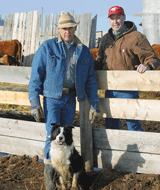| |
 Many Alberta farms are particularly busy working with livestock at this time of year. Through the stress of calving, lambing, sorting, processing, and relocating — often during inclement weather — farmers and ranchers need to consider their safety and that of others while tending to their animals. Many Alberta farms are particularly busy working with livestock at this time of year. Through the stress of calving, lambing, sorting, processing, and relocating — often during inclement weather — farmers and ranchers need to consider their safety and that of others while tending to their animals.
“The biggest factor in livestock handling safety is understanding animal behaviour,” says Jennifer Woods, livestock handling specialist based in Blackie, Alberta. “Workers need to be trained in this aspect before they are tasked with handling livestock. It is important to know that animals don’t necessarily react to their environment the way we would expect.”
Many times, the cause of injury to handlers is overconfidence in their ability to predict or read animal behaviour. Workers can get too complacent and not pay attention to the situation. “What makes animal behaviour so different from humans is that animals truly live in the moment and react accordingly to the things they hear, smell, see, and feel. People usually do not perceive the same things animals perceive,” says Woods.
In general, calm animals are safer animals, and the best way to keep them calm while handling them is to reduce fear and anxiety. As a prey species, cattle have an inherent fear of unfamiliar objects, situations, smells, sudden movements, and noises. Animals that are singled out of a herd, injured or sick, are also more fearful.
Woods points out the indicators when animals tend to be more unpredictable, and handlers must be particularly cautious. They are:
- During breeding season
- During calving/lambing/foaling
- When animals are alone
- When animals have been harassed by a predator
- When animals are injured or sick
- When animals are in an unfamiliar environment or around unfamiliar handlers
Other contributors to worker safety are the condition of the handling equipment and facilities, proximity of the handler to the livestock, and the physical size of the worker handling the livestock. Small children are at a considerable size disadvantage for many tasks, for example. In particular, workers need to be aware when they are in the kick zone of cattle.
For long-term worker safety, Woods advises handlers to cull dangerous cows. “If there is a risk of them hurting a worker or family member, it is not worth it to keep them around. Even if that cow is a good producer, she will pass her bad behaviour on to her calves, and you don’t want that perpetuating in your herd.”
As for sheep, Woods says that the smaller animals, generally speaking, tend to be more likely to get hurt during processing than a worker, but you still need to pay attention to avoid getting butted or knocked over. Although extra caution needs to be taken with rams as they can be quite dangerous. She cautions that sheep can take a child out in a minute, “Adult supervisors need to make sure children are out of harm’s way during all aspects of livestock
handling.”
More information on livestock handling can be viewed on Woods’ website at www.livestockhandling.net. For more information farm safety, go to www.agriculture.alberta.ca/farmsafety. |
|